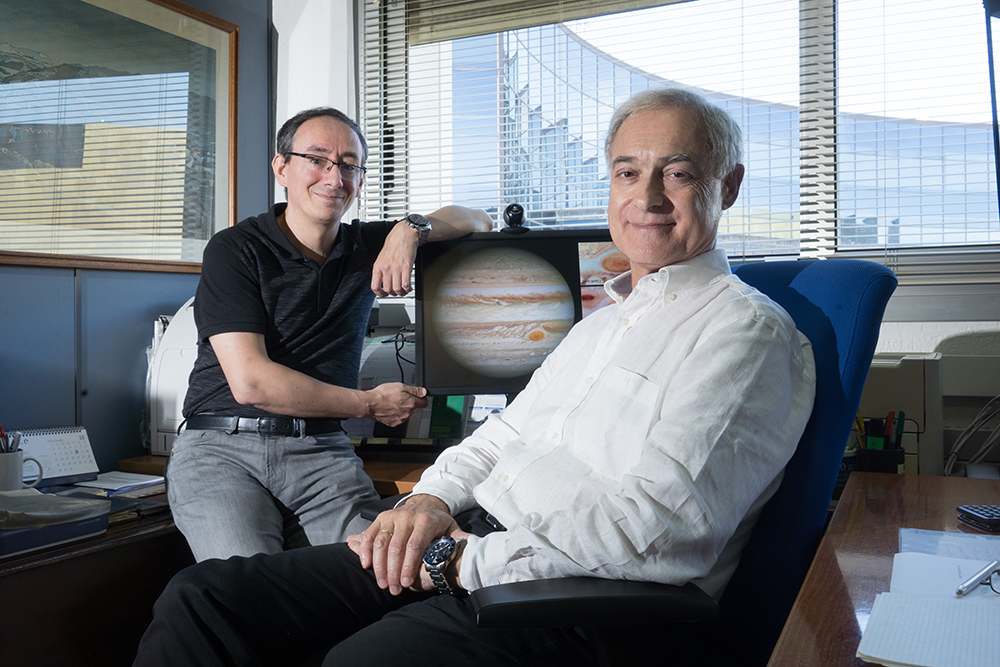A piece of research conducted by an international team of researchers led by Agustín Sánchez-Lavega, professor of Physics at the UPV/EHU and winner of the 2016 Euskadi Award for Research, reveals the existence of a rich diversity in the atmospheric phenomena confined inside the Spot as a result of the intense hurricane winds blowing around its periphery at speeds of about 450 km/hour.
The rich variety in the meteorological phenomena at Jupiter’s Great Red Spot are revealed
The UPV/EHU-University of the Basque Country professor Agustín Sánchez-Lavega leads the study that has used images obtained by NASA’s Juno space mission
- Research
First publication date: 19/10/2018

The Astronomical Journal has published the work and has selected it among its news highlighted by the American Astronomical Society. Jupiter’s Great Red Spot, a huge, long-lived, oval-shaped whirlwind, measuring 20,000 km, is perhaps one of the most popular atmospheric phenomena in the solar system; according to this study, contains cumulus clouds of clustered storms produced by the condensation of ammonia vapour, narrow gravity waves similar to those that form on the Earth when the wind blows on mountain summits. Yet calm reigns at its centre where the clouds move by rotating in the opposite direction at maximum speeds of only 25 km/hour.
“These phenomena are confined to a thin layer only 50 km thick, which represents the roof of the clouds of the Spot, while inside, the Spot probably goes down to a depth of a couple of hundred kilometres,” say the researchers, using the images taken by the JunoCam after its close flyby across the Great Red Spot. These and other aspects of this phenomenon are the focus of the research that the Juno mission will be conducting over the next few years.
The Great Red Spot, observed for the first time with certainty 150 years ago, shows up through the telescope owing to its reddish colour against the white, yellowish, ochre clouds on the rest of the planet. Despite the numerous studies conducted on this phenomenon, its nature poses a huge challenge for planetary meteorologists.
NASA’s Juno space mission, launched for the purpose of studying the deep atmosphere of Jupiter, the planet’s interior and its complex magnetic field, went into orbit in July 2016. Among the scientific equipment it has on board is a camera called the JunoCam, designed to capture images of the planet for popularisation purposes and for encouraging citizen participation in science. The first images sent back from the environs of Jupiter suggested the potential scientific use of the camera as it showed details of the atmosphere down to 7 km/pixel, a resolution never achieved previously.
Meteorite impacts on Jupiter
What is more, in another piece of work by the Planetary Sciences Group led by Richard Hueso, a study is presented of the impacts of meteorites on the atmosphere of Jupiter detected over the last few years by amateur astronomers across the world. Between 2010 and 2017 five flashes of light lasting barely a second caused by objects of between 5 and 20 metres in size were captured. Calculations indicate that between 10 and 65 impacts by objects of this size may take place every year on Jupiter even though it is tricky to spot them because they last for such a short time. This work was echoed by the journal Nature in its Research Highlights section of 4 October. References Nature Research Highlights:
Bibliographic reference
- The rich dynamics of Jupiter’s Great Red Spot from JunoCam – Juno images
- Astronomical Journal, 156, 162 (9pp). 2018.
- DOI: 10.3847/1538-3881/aada81
Image gallery
-

Image of Jupiter’s Great Red Spot obtained by the JUNO (NASA) space probe. The movements are shown in detail and are indicated (yellow arrows): (A) convective cumuli; (B) gravity waves; (C) internal vortices; (D) turbulent core; (E ) long waves. Acknowledgements: Grupo Ciencias Planetarias UPV/EHU/JunoCam/NASA/SWRI -

Ricardo Hueso and Agustín Sánchez Lavega, Photo: Mitxi. UPV/EHU.








